1. INTRODUCTION
Industrial and sewage wastewater are continuously disposed of in open drains whose water is used for irrigation [1,2]. These wastewaters contains huge amount of heavy metals e.g. iron (Fe), manganese (Mn), lead (Pb), copper (Cu), zinc (Zn), chromium (Cr), cobalt (Co), nickel (Ni), and cadmium (Cd) along with organic matter and nutrients. Crops irrigated by wastewaters store and secrete these heavy metals through various parts. These heavy metals cause serious health effects when consumed through foods [1,6]. Many clean-up technologies exist for the treatment of contaminated soils, but only a few are applicable to heavy metal contaminated soils. The use of plants and associated
microorganisms to contain, inactivate, remove or degrade harmful environmental contaminants and to revitalize contaminated sites is gaining more and more attention [3]. Plants and leafy vegetables have a high capacity to bioaccumulate these heavy metals when grown in soil irrigated by wastewater [4,5,6] Irrigation can impact potential yield by affecting morphological and physiological traits. Irrigation of crops by wastewater for a long period of time causes increased concentration of heavy metals in plants and vegetables through bioaccumulation [7,8]. Heavy metals accumulate in all parts of vegetables with only a few eg Zn, Ni, Cu that are essential for body function at low concentration, Zn at high concentrations causes abnormal functions of reproductive activities [8,9,10,11]. Vegetables constitute an important part of the human diet since they contain carbohydrates, proteins, as well as vitamins, minerals and also a source of micro and macro elements. Heavy metals are one of a range of important types of contaminants that can be found on the surface and in the tissue of fresh vegetables
[12,13]. A number of elements, such Pb, Cd, Ni, Co, Cr, Cu and Selenium (Se) can be harmful to plants and humans even at quite low concentrations [14,15,16].
Soil pollution is caused by misuse of the soil, such as poor agricultural practices, disposal of industrial and urban wastes, etc. The soil is also polluted through the application of chemical fertilizers (like phosphate and Zn fertilizers), and herbicides [17,18,19]. Heavy metal accumulation in soils is of concern in agricultural production due to the adverse effects on food quality, crop growth, and environmental health. Plant species have varying capacities of removing and bioaccumulating heavy metals. Researches have shown that some plant species selectively bioaccumulate heavy metals [21,22,23]. Vegetables, especially leafy vegetables, bioaccumulate higher amounts of heavy metals [23]. Roots and leaves of herbaceous plants retain a higher concentration of heavy metal than stems and fruits [12]. There are limited studies on heavy metal content at different growth stages of vegetables, available studies focused on the status of metal content inedible parts of vegetables [15]. A review of the literature also showed the scarcity of data on the comparison of metal content on different leafy vegetable species in Hawul [15]. Potentially harmful metal contents in soils may come not only from the bedrock itself, but also from anthropogenic sources like solid or liquid waste deposits, agricultural inputs, and the fallout of industrial and urban emissions [24]. Excessive accumulation in agricultural soils may result not only in soil contamination but has also had consequences on food quality and safety. So, it is essential to monitor food quality, given that plant uptake is one of the main pathways through which heavy metals (HMs) nter the food chain [25]. Vegetables are very important because they contain essential components of protein, vitamins, iron, calcium and other nutrients [26,27]. However, their nutritional value andconsumer acceptance as food must be taken into consideration, because vegetables can contain both essential and non-essential elements over a wide range of concentrations [28,29]. It is well established that the daily intake of heavy metal contaminated vegetables may pose a risk to human health. This is because heavy metals can bioaccumulate in living organisms and at elevated levels, they can be toxic. It has been reported that prolonged consumption of unsafe concentrations of heavy metals through foodstuffs may lead to the chronic accumulation of metals in the kidney and liver of humans, causing disruption of numerous biochemical processes, leading to cardiovascular, nervous, kidney, and bone diseases [31,32,33]. Absorption and accumulation of heavy metals in vegetables and fruits are influenced by many factors, such as their solubility, soil pH, plant species; soil type, the concentration of heavy metals in soil, composition, and intensity of atmospheric deposition, including precipitations, the phase of plant vegetation [21,34]. To all of these, can be added other sources generated by agricultural technologies such as irrigation with wastewater, the administration of organic and mineral fertilizers with a load of heavy metals, or application of pesticides, which contain in their structure as chemical elements [35]. Urban, industrial, household activities and traffic contribute significantly to increasing the load degree of heavy metals containing particles of inferior atmosphere [34]. The intake of heavy metals can lead to altering of humans and animals state of health. Thus, the carcinogenic effects generated by the continuous consumption of fruits and vegetables loaded with heavy metals such as Cd, Pb or even Cu and Zn are known. There are already published works related to the incidence of gastrointestinal cancer, cancer of the pancreas, urinary bladder or prostate [1,28]. In Romania, there are three areas (CopÅŸaMică-Sibiu County, Zlatna – Alba County and Baia Mare
– Maramures County) that are strongly polluted with heavy metals, caused by nonferrous ores extraction and metallurgical processing. The concentrations of heavy metals in the soils around these localities are higher than the maximum allowable limits. As a result, the plants, including vegetables, bioaccumulated high quantities of such chemical elements [14, 15]. Human exposures to heavy metals may occur through inhalation of air or ingestion of food and water. Heavy metals concentration in the environment varies markedly depending on their concentrations in soil and vicinity to sources of emission [36,37]. Heavy metal accumulation in soil and plants is of increasing concern because of the potential human health risk. Food chain contamination is one of the most important pathways for the entry of these toxic elements into the human body. Phytoremediation, also known as green technology, which consists of the use of plants including trees, grasses, herbs and aquatic plants to extract, sequester, and detoxify heavy metals, is a novel approach that has shown considerable promise as a cost-effective and an environmentally friendly technology and has received much attention in recent years [40,41,42]. In this technique, the natural capacity of plants is used to extract some elements and compounds from soil and translocate them between fruits, flowers, leaves, stems, and roots relating to the biological stage in which the elements and compounds are involved [43,44]. Phytoremediation of heavy metals is divided into three categories: phytoextraction, which shows theability of plants to extract heavy metals from soil by accumulating the metal in aerial parts of plant [45,46,47]; phytostabilization, which is the use of plants to stabilize the soil surface by maintaining the metals in the roots [48,49]; and rhizofiltration, which is the use of plant roots to ab/adsorb metals from water and aqueous waste streams [50,51]. This research thereby determine the phytoextraction efficiency and the risk associated with vegetables grown from soil irrigated with wastewater from refinery since this wastewater is used for vegetable farming at the bark of Romi stream and River Kaduna when it finally makes it way into this stream and river respectively.
2. MATERIAL AND METHODS
2.1. Water Sampling and Analysis
Wastewater was collected from effluent point discharge of Kaduna Refining and Petrochemical Company from October 2016 to February 2018 and transported to the laboratory for analysis of heavy metals (Cd+2, Hg+2, Ag+2 and Pb+2, Cr+3) before used for irrigation.
2.2. Soil Collection and Analysis
Soil samples were collected from a farm located in Rigasa, Igabi Local Government of Kaduna State. The samples were collected from this location because it is an area of minimal anthropogenic activities such as industrial, artisanal or water body for irrigation that can lead to heavy metal pollution. Surface soil (0-20 cm) samples were collected using a stainless steel grab sampler. The sampler was inspected for possible cross-contamination and cleaned with ambient water for individual sample collection. The soil was sampled from the central part of the grab sampler by avoiding contact with the inside materials of the sampler and transferred to a pre-cleaned plastic container [52]. The surface soil samples were collected in pre-cleaned zipper polythene bags, which were kept in airtight large plastic containers [53]. Soil samples were air-dried, grounded into fine powder and passed through 2-mm mesh sieve and stored at ambient temperature prior to analysis. The soil samples were digested and analyzed for heavy metal (Cd+2 , Hg+2, Ag+2 and Pb+2, Cr+3) and physicochemical parameter using the method employed by Yoon
2.2. Plants Collection and Identification
The seed of the vegetables (table 2) used for this research was purchase in Bakin-Dogo market located in Kaduna south local government, Kaduna, Nigeria.
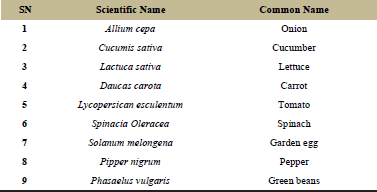 | Table 1: Plants used for Phytoextraction. [Click here to view] |
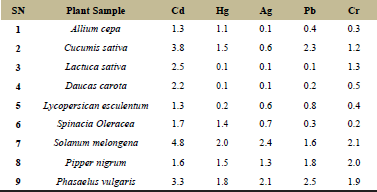 | Table 2: Biotranslocation Factor of Vegetables Irrigated with Refinery Wastewater. [Click here to view] |
2.4. Experimental Setup
The purchase seeds were planted in the botanical garden of the Biological Sciences Department of Kaduna State University and constantly irrigated by refinery wastewater throughout the period of the research. After germination, the plants were harvested and separated into root/rhiziome and shoot, the root/rhiziome and shoot. The separated plant parts were digested and heavy metals analysis was carried out using AAS. Bioconcentration factor and Bio translocation factor were thus calculated using the method of Ugya
3. RESULT AND DISCUSSION
The bioaccumulation and translocation abilities of the plant species varies by species of plant and irrigation source. It was reported that the accumulation of metal by a plant depends on factors such as physicochemical parameters of soil (table 6), the plant species involved, climatic condition and speciation of metal [57,58,59]. The heavy metals content of the soil generally changes with irrigation of the soil with refinery wastewater and this had led to the accumulation of the heavy metal in the edible part of the vegetables which is detrimental to human health [60,61]. The accumulation trend in the vegetable for Cd and Hg is
b.w. per day for heavy metals from the lowest Non-Observed Adverse Effect Level (NOAEL) identified in a (National Toxicology Program) NTP chronic oral toxicity study in rats [71]. The presence of these metals into the food chain may either in the long run or short span affect human health and creates toxicity which can result in nausea, vomiting, abdominal pains, anorexia, constipation, insomnia, anemia, irritability, mood disturbances, coordination loss and neurological effect [71,72,64]. In the consumption habits of local residents, the leafy vegetable consumption accounted for 70% of total consumption of vegetables, while other vegetables amount to 30% [73,70]. Chronic low-level intake of toxic metal elements has a negative effect on human health, and the detrimental impact becomes apparent after several years of exposure [74,75].
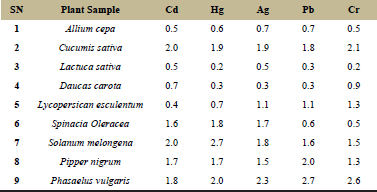 | Table 3: Mean Bioconcentration Factor of Vegetables Irrigated with Refinery Wastewater. [Click here to view] |
 | Table 4: Mean Health risk index (HRI) arising out of consumption of vegetables irrigated with Refinery Wastewater. [Click here to view] |
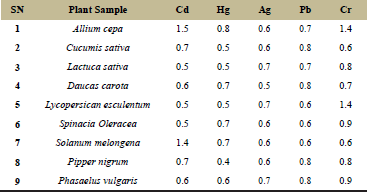 | Table 5: Daily Intake of Heavy Metals (DIM) (mg/kg bw/day) arising out of consumption of vegetables irrigated with Refinery Wastewater [Click here to view] |
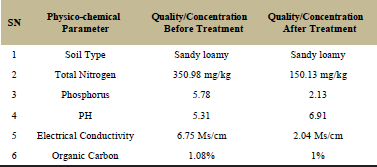 | Table 6: Physico-chemical Parameter of Soil Sample [Click here to view] |